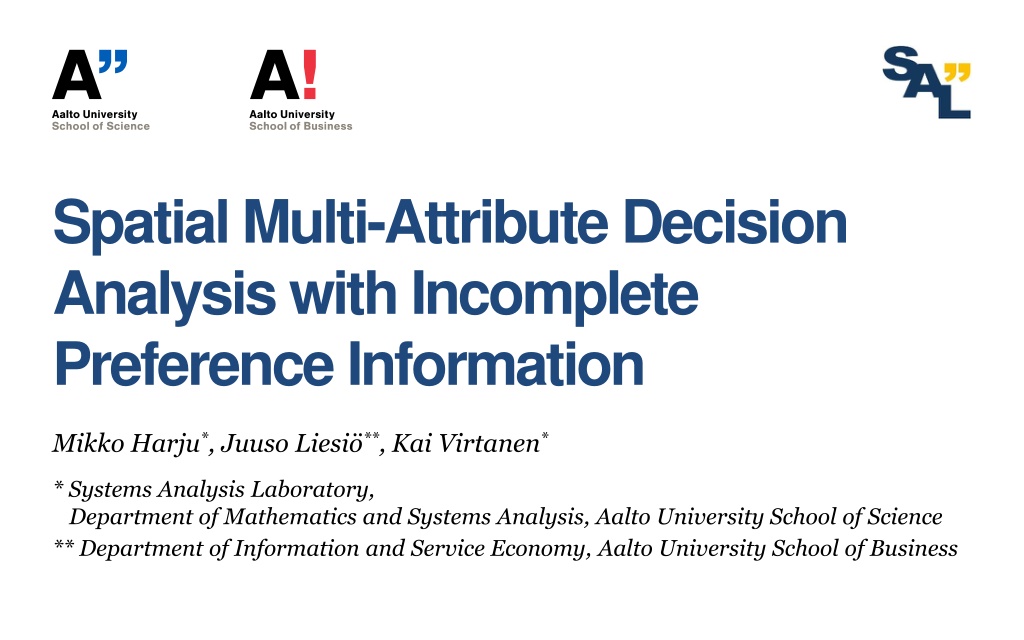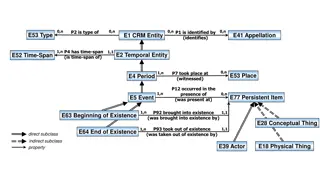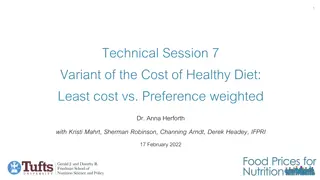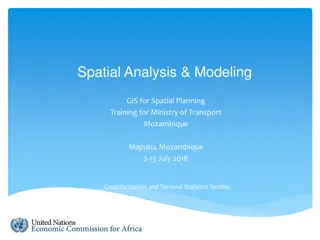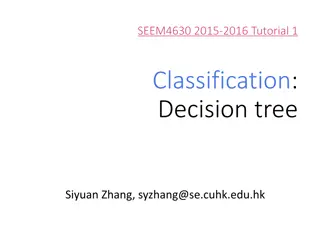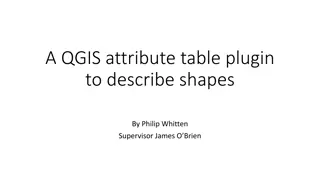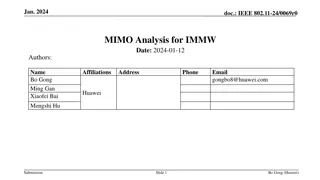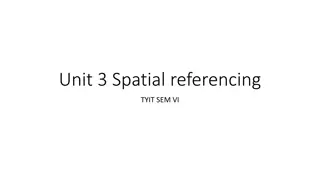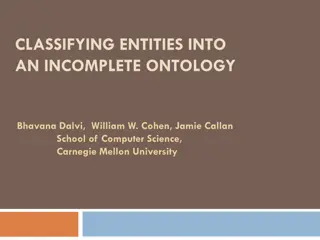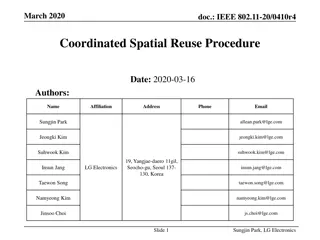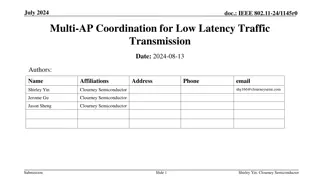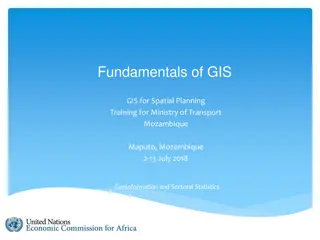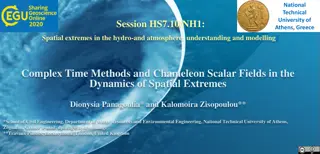Spatial Multi-Attribute Decision Analysis with Incomplete Preference Information
In this study by Mikko Harju, Juuso Liesi, and Kai Virtanen from Aalto University, the focus is on spatial decision analysis for scenarios where decision alternatives have varying consequences across a geographical region. The research delves into the significance of spatial value functions in representing preferences and determining dominance among alternatives. Challenges like specifying spatial weights for numerous locations are highlighted, along with axiomatic foundations for handling incomplete preference information.
- Spatial Decision Analysis
- Multi-Attribute Decision Analysis
- Incomplete Preferences
- Spatial Value Function
- Aalto University
Download Presentation

Please find below an Image/Link to download the presentation.
The content on the website is provided AS IS for your information and personal use only. It may not be sold, licensed, or shared on other websites without obtaining consent from the author. Download presentation by click this link. If you encounter any issues during the download, it is possible that the publisher has removed the file from their server.
E N D
Presentation Transcript
Spatial Multi-Attribute Decision Analysis with Incomplete Preference Information Mikko Harju*, Juuso Liesi **, Kai Virtanen* * Systems Analysis Laboratory, Department of Mathematics and Systems Analysis, Aalto University School of Science ** Department of Information and Service Economy, Aalto University School of Business
Spatial Decision Analysis Alternative 1 Decision alternatives have consequences that vary across a geographical region Example: select position of a rescue helicopter base, ?1or ?2 Alternatives imply different response times, or consequences, for each location Locations not equally important? (population density, infrastructure) Numerous applications Urban, environmental and transportation planning Waste management, hydrology, agriculture, and forestry See, e.g., Malczewski & Rinner 2015, Ferretti & Montibeller 2016 ?1 Alternative 2 ?2 Long Short Response time
Spatial Value Function Value of decision alternative ? (Simon, Kirkwood, and Keller 2014): ? ? = ? ? ? ? ? ?? ? ? ? : spatial weight ( importance ) of specific location ? in region S ? ? : consequence at location ? when alternative ? is chosen ? : consequence value function Our contribution: Axiomatic foundation for representing preferences with the spatial value function Incomplete preference information determining dominances among alternatives based on preference statements Challenges: Specifying spatial weights ?(?) for an infinite number of locations ? Only a conjecture on the underlying preference assumptions
Preference Assumptions A3: Preference between two alternatives does not depend on locations with equal consequence Let be a binary relation on the set of decision alternatives ? = ?:? ? ?: set of locations ?: set of consequences Assumptions A1 is transitive and complete A2 There exist ?1,?2 ? such that ?1 ?2 A3 Spatial preference independence A4 Consequence consistency A5 Spatial consistency A6 Divisibility of subregions A7 Monotonicity ?1 ?2 ?4 ?3 Consequences ? Least preferred Most preferred
Additive Spatial Value Function ? ? Theorem. satisfies A1-A7 iff there exists a non-atomic measure ? on ? and a bounded function ?:? such that ? ? ? ? ? ? where ? ? = ? ? ? ?? ? ? Proof based on Savage 1954 Spatial weighting function for subregions ?:2? + Assigns a spatial weight to each subregion ? ? (cf. relative importance) Connection to Simon s et al. weighting ? ? : ? ? = ? ? ? ?? Cardinal value function for consequences ?:? Assigns a value to each consequence independently of location ? E.g., additive multiattribute ? ? ? = ?=1 ???? ???
Incomplete Preference Information ?1 ?2 Compare alternatives without precisely specifying the weighting Spatial weighting function ? Vector ? of attribute weights Stated preference between suitable pair of alternatives Linear constraint on ? or ? Multiple preference statements Partition ?1, ,??of the region ? Linear constraints on ? ?1, ,? ?? Linear constraints on ?1, ,?? ?2 ?1 ?1 ?2 ? ?1 ? ?2 ? ?1 ? ?2 Subregion ?1is more important than ?2 Consequences ? Least preferred Most preferred
Dominance Constraints from preference statements result in A set of feasible spatial weighting functions ? {?:2? +? ? = 1 A set of feasible attribute weights ? {? + ?1 and ?3 non-dominated ? ??= 1 ?3 Alternative ?1dominates alternative ?2if ? ?1 ? ?2for all ? ? and ? ? ? ?1> ? ?2for some ? ? and ? ? ?(?) ?1 ?2 An alternative that is not dominated by any alternative is non-dominated ?,?
Comparison of Non-Dominated Alternatives No definite answers, only decision support Dominance graph which alternative dominates which Value intervals interval of possible values for each alternative Decision rules Maximin Minimax-regret
Air Defense Planning: Positioning of Air Bases Select positions for air bases from a list of candidates Main bases: 2 out of 3 candidates Secondary bases: 3 out of 5 candidates Threat 30 possible combinations, or decision alternatives Large city City Power plant Threat
Attributes of Air Defense Capability Force fulfillment Attribute #1: Average number of defensive flying units available at the location Attribute #2: As attribute #1, but with a secondary base destroyed (combat sustainability) Attribute #1 Attribute #2 Engagement frontier where hostiles can first be intercepted by aircraft on alert at the bases Attribute #3: Location s distance to south frontier Attribute #4: Location s distance to west frontier Attribute #3 Attribute #4 Consequences ?? Least preferred Most preferred
Spatial Preference Statements (?) Partition into 9 areas (thick borders) Order of importance: Nuclear Plants 1. Nuclear Plants 2. Capital Area 3. Major Cities 4. South Area 5. West Area 6. Central Area 7. East Area 8. North Area 9. Island Major Cities Capital Area ? Nuclear Plants ? Capital Area ? Major Cities
Spatial Preference Statements (?) How is the spatial weight allocated within each area? Split into smaller subregions (thin borders) E.g., for Nuclear Plants: Plant A is more important than Plant B but not by more than 50% ? Plant A ? Plant B ? Plant A 3 Plant B Plant A 2? Plant B Similar statements for each area
Attribute Preference Statements (?) Western engagement frontier Southern engagement frontier Southern engagement frontier Force fulfillment Threat Force fulfillment Force sustainability Force fulfillment + Force sustainability Western engagement frontier Threat
Dominances 3 5 4 17 non-dominated alternatives Secondary base position candidate 3 is included in all non-dominated alternatives All other candidates are included in some, but not all, non-dominated alternatives A C More preference information is needed! B 2 1 Main base Secondary base Large city Power plant
Additional Preference Statements A ranking of the areas is not enough Is one area 50% more important than the next one? ? Nuclear Plants 3 Nuclear Plants 2? Capital Area North Area ? Capital Area 3 2? Major Cities ? North Area 3 Major Cities Capital Area 2? Island Island
Dominances Three non-dominated alternatives: BC123, BC234, and BC235 Main bases at B and C Secondary bases at 2 and 3 Three options for the final secondary base 3 5 4 A C B 2 1 Main base Secondary base Large city Power plant
Non-Dominated Alternatives Similar value intervals 3 5 4 A C B 2 1 Maximin recommendation: BC123 Minimax-regret recommendation: BC235 Main base Secondary base Large city Power plant
Conclusion The additive spatial value function Axiomatic basis Weighting subregions rather than locations Incomplete preference information & non-dominated decision alternatives Burden of DM eased considerably by not requiring unique spatial weighting Global sensitivity analysis: Effect of spatial weighting on ranking of alternatives Future development Practices and behavioral issues of eliciting the spatial weighting function Spatial decision support systems: Graphical user interface, utilization of GIS data
References Ferretti, V. and Montibeller, G., 2016. Key challenges and meta-choices in designing and applying multi-criteria spatial decision support systems. Decision Support Systems, 84 Malczewski, J. and Rinner, C., 2015. Multicriteria decision analysis in geographic information science. New York: Springer Salo, A. and H m l inen, R.P., 1992. Preference assessment by imprecise ratio statements. Operations Research, 40(6) Savage, L.J., 1954. The foundations of statistics. New York: John Wiley and Sons Simon, J., Kirkwood, C.W. and Keller, L.R., 2014. Decision analysis with geographically varying outcomes: Preference models and illustrative applications. Operations Research, 62(1)
